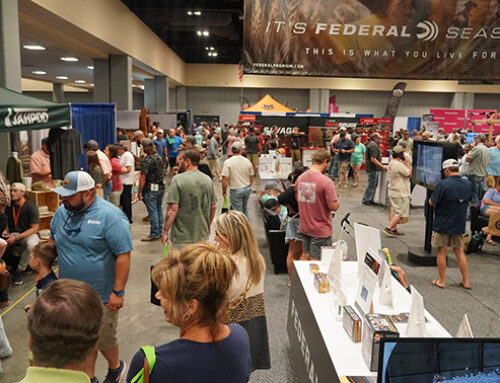USFWS Report: U.S. Waterfowler Numbers, Duck & Goose Harvest Increased in 2020-2021

The U.S. Fish and Wildlife Service’s 2021 Migratory Bird Hunting Activity and Harvest report shows hunter numbers and waterfowl harvests were up during the 2020-2021 hunting season. Here is a roundup of which states had the biggest gains, what species were most harvested and other intriguing statistics from the newest data.
Hunters Retake 1 Million Mark
According to the report, there were 1.04 million active waterfowl hunters in the United States during the 2020-2021 season, up from 989,500 in 2019-2020. This data confirms anecdotal state reporting throughout the year of increased hunting participation attributed to the Covid pandemic. The 2019-2020 numbers represented only the third time in 81 years of reporting that total waterfowl hunters in the U.S. had ticked below a million.
Despite the uptick last season, the trend line continues its decline since reaching a high of 2.03 million waterfowlers in 1970. Delta Waterfowl remains committed to reversing this trend in the U.S. and Canada through its HunteR3 programs including First Hunt, Defending the Hunt and the University Hunting Program.
Duck, Goose Harvests Rise
With more than 50,000 more hunters afield, it stands to reason the number of birds bagged during 2020-2021 increased as well. The duck harvest in the Lower 48 states of 11.14 million was up nearly 1.5 million from the harvest of 9.8 million in 2019-2020 for an increase of a whopping 15 percent on the 5 percent gain in hunter numbers.
Increased duck harvest numbers got out of the gate early with historic success in the early teal seasons held in 26 states. In 2019, the special teal season harvest was 388,079 (plus 9,313 wood ducks in states where they are also legal in the special season). In 2020, that harvest jumped to 683,205 (plus 18,162 wood ducks) — nearly doubling the previous season’s take!
The total goose harvest in the 48 contiguous states jumped 7 percent from 2.69 million in 2019-20 to 2.88 million in 2020-2021. The Canada goose harvest accounted for about 65,000 of the increase. And though the 2020 breeding season for light geese was widely considered a bust due to a late spring in much of the far north, the number of light geese taken increased by more than 110,000 birds. This could be due, in part, to the 2020 explosion of the snow goose population on Wrangel Island feeding the Pacific Flyway. Nationwide, the speckebelly harvest increased by about 10,000 birds, while the brant harvest again fell slightly by approximately 2,000 birds.
While the nationwide mallard harvest dropped by about 3.25 percent, greenheads continue to be the most commonly harvested species, with 2.8 million taken in 2020-2021.
Strong teal hunting success continued through the regular waterfowl seasons as well. The total number of bluewings taken jumped from 802,057 in 2019-2020 to more than 1.1 million in 2020-2021. That’s 300,000 more birds — a 27.6 percent increase. The greenwing harvest climbed to 1.42 million for a 17.6 percent increase over the previous season’s bag of 1.17 million.
Two more duck species topped the million-bagged mark during 2020-2021. They were gadwall, with a total harvest of 1.25 million (up 16 percent), and wood ducks, with 1.12 million bagged (up 14 percent).
So if you’re keeping track, the top five duck species harvested in the 2020-2021 season were:
Mallards 2,801,212
Green-winged Teal 1,419,863
Gadwalls 1,250,504
Wood Ducks 1,116,545
Blue-winged/Cinnamon Teal 1,108,012
In aggregate, these five species represent approximately 40 percent of the total duck harvest in the Lower 48 states.
The most harvested diver species is annually ring-necked ducks. Hunters took 435,025 ringers during the 2020-2021 season, which was up from 374,088 from the previous year. Buffleheads, redheads, lesser scaup and common goldeneyes rounded out the top five divers.
Flyway Totals
In the Atlantic Flyway, 216,300 waterfowlers bagged 1.36 million ducks and 418,600 geese. North Carolina cracked the 30,000 hunter mark to again lead the flyway, but Pennsylvania moved into second for most active waterfowlers with 25,800. It’s notable that in a year of overall increased participation, Maryland and New York hunter numbers declined. The Tar Heel State’s duck harvest of 323,400 is the most in the East by more than double South Carolina’s second place take of 141,300. While the overall Atlantic Flyway goose harvest was down 5 percent, Vermont and Maine doubled their takes over 2019-2020 and significant gains were seen in 7 other states. The big declines in goose harvest were in New York, North Carolina and Pennsylvania.
The Mississippi Flyway’s 428,700 waterfowlers shot 4.41 million ducks and 1.06 million geese — both up from 2019-2020 and again by far the largest waterfowl harvest of any flyway. Wisconsin and Minnesota jumped to the top in Mississippi Flyway waterfowl hunter numbers with 67,100 and 60,100, respectively. Though dropping significantly from the 2019-2020 harvest of 1.1 million ducks to 889,000 in 2020-2021, Arkansas maintained the top harvest in the flyway. Last season’s duck harvest in Louisiana jumped by 24 percent over the previous year to 752,200 and placed it firmly in the second spot. As for geese, Michigan hunters took the most last season, with 171,000 bagged, followed by Wisconsin with 164,400 and Minnesota with 145,800. Minnesota’s goose bag was down significantly, however, from the previous season when Gopher State hunters took more than 200,000.
Numbers were up, up and up in the Central Flyway, as well. During the 2020-2021 season, 226,900 hunters took almost 2.8 million ducks and nearly 800,000 geese. The duck harvest increased 24 percent from 2.11 million the previous year. With 84,300 active waterfowl hunters, Texas accounted for 37 percent of the flyway’s hunters. Not surprisingly, Lone Star State hunters also had the flyway’s largest duck harvest, totaling almost 1.2 million birds or 43 percent of the ducks taken in the entire flyway. North Dakota’s duck harvest of 446,600 was the second highest tally in the flyway last season. Oklahoma saw terrific growth in year-to-year harvests; bagged ducks were up 28 percent to 383,700 and geese were up 30 percent to 92,300.
In the Pacific Flyway, 164,900 waterfowlers bagged more than 2.5 million ducks and 594,600 geese — all representing substantial increases over the 2019-2020 season. California had the most waterfowl hunters at 52,300, and they topped the million mark in duck harvest at 1.1 million — a 12 percent increase. California also boosted its goose harvest to 290,500, which is 38 percent higher than the previous season. Montana also saw great gains in hunters and harvests. Big Sky Country boosted its participation by 24 percent, its goose harvest by 23 percent and its duck harvest by a whopping 52 percent over the 2019-2020 season.
— Bill Miller






I find it heard to believe that there is anyway to know the numbers of harvested birds. There are no check and balance that backs these numbers up. I look at a lot of waterfowl sights and see the dismay in all the comments that not one state is having any great success. I do see something needs to be done with private clubs and refuges that provide food. It is killing the natural migration pattern. I do not believe the total numbers of waterfowl that DU or USFW say we have.
I agree with the previous comment, there is no way to accurately know the number of ducks and geese harvested. I myself hunt about 50days a year a nobody including myself know how many birds I harvested. I believe part of the increase in total bird numbers is do to more ways to access areas and count birds such as drones and cameras linked to cell towers and wifi etc.
[…] the Globe’s editors that the duck harvest by hunters in the lower 48 U.S. states alone was 11.14 million birds killed in 2020-2021, up from the harvest of 9.8 million in 2019-2020, due to a 5 percent increase in hunter […]